Have you ever wondered what it feels like to step back in time and wander through the captivating tales of centuries past? Picture this: ancient temples whispering tales of dynasties, ornate palaces echoing the grandeur of bygone eras, and mysterious ruins preserving the secrets of a rich cultural tapestry. Why include a visit to historical sites in Thailand, you ask? Well, it’s not just about ticking off tourist attractions; it’s about unlocking the door to a living history that weaves the present with the past.
Thailand’s historical sites aren’t mere relics; they’re immersive time machines that transport you to a world where tradition dances hand in hand with innovation. So, buckle up for a journey beyond the surface – where every stone has a story, and every visit is a step into a vibrant narrative waiting to be uncovered.
Why Include a Visit to Historical Sites in Thailand?
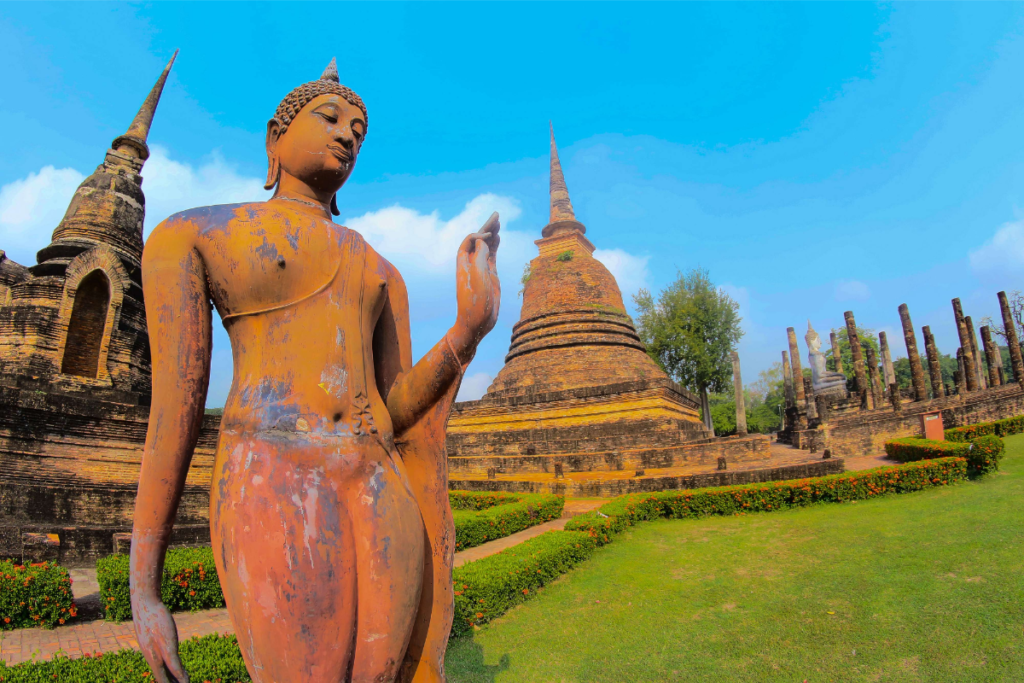
So, why include a visit to historical sites in Thailand? Nestled in the heart of Southeast Asia, Thailand boasts a tapestry woven with the threads of time, each strand telling a tale of resilience and evolution. Dating back to ancient civilizations, the roots of Thailand’s history delve deep into the soil of the Ayutthaya and Sukhothai periods, where kingdoms rose and fell, leaving behind a legacy etched in stone and spirit. From the rise and fall of dynasties to pivotal historical milestones, Thailand’s rich history is a captivating chronicle that continues to shape its present.
✔️Cultural Diversity:
Step into the kaleidoscope of Thailand’s cultural diversity, a harmonious blend of influences that transcend borders and time. Shaped by neighboring cultures such as China, India, and Cambodia, Thailand’s cultural identity is a testament to the ebb and flow of maritime trade routes. The mosaic is further enriched by the tapestry of ethnic diversity within the nation, where various groups contribute their unique hues to the vibrant canvas of Thai culture. From traditional arts and crafts to the mesmerizing performing arts, Thailand’s cultural diversity is a celebration of creativity passed down through generations.
✔️Architectural Marvels:
Marvel at the architectural wonders that dot the landscape of Thailand, each structure a testament to the nation’s spiritual and cultural identity. With its intricate details and ornate designs, Thai temple architecture reflects the deep-rooted reverence for spirituality. Royal palaces are majestic symbols, showcasing the synthesis of traditional Thai design and external influences. Notable historical sites, adorned with the remnants of bygone eras, beckon visitors to immerse themselves in the tangible history etched in stone.
✔️Artistic Expression:
Dive into the realm of artistic expression that defines Thai culture, from traditional arts and crafts to the captivating world of performing arts. Passed down through generations, traditional arts and crafts reveal the skill and creativity embedded in everyday life. The performing arts, including dance, music, and drama, captivate audiences with their vibrant storytelling and cultural resonance, bringing the past to life on modern stages.
✔️Dynastic Rule and Governance:
Uncover the historical narrative of dynastic rule and governance that has shaped Thailand’s administrative landscape. The monarchy, a central pillar of Thai history, has played a pivotal role in governance and cultural continuity. Explore the administrative systems implemented by various Thai dynasties, each leaving an indelible imprint on the nation’s path through time.
✔️Cultural Preservation Efforts:
Celebrate the endeavors to preserve Thailand’s cultural heritage through UNESCO World Heritage Sites, safeguarding the tangible remnants of the nation’s history. Museums and archives stand as guardians, protecting historical artifacts and documents that tell the story of Thailand’s past. These efforts ensure that the cultural legacy is preserved and shared with future generations.
Thailand’s historical background and cultural diversity are not mere chapters in a book but living narratives that invite exploration and appreciation, beckoning travelers to immerse themselves in the living history that defines the Land of Smiles.
Top Historical Sites to Visit in Thailand
So, what are the top sites you can visit in Thailand? Below are the most visited historical sites in the country.
📌Ayutthaya, Thailand’s Ancient Capital
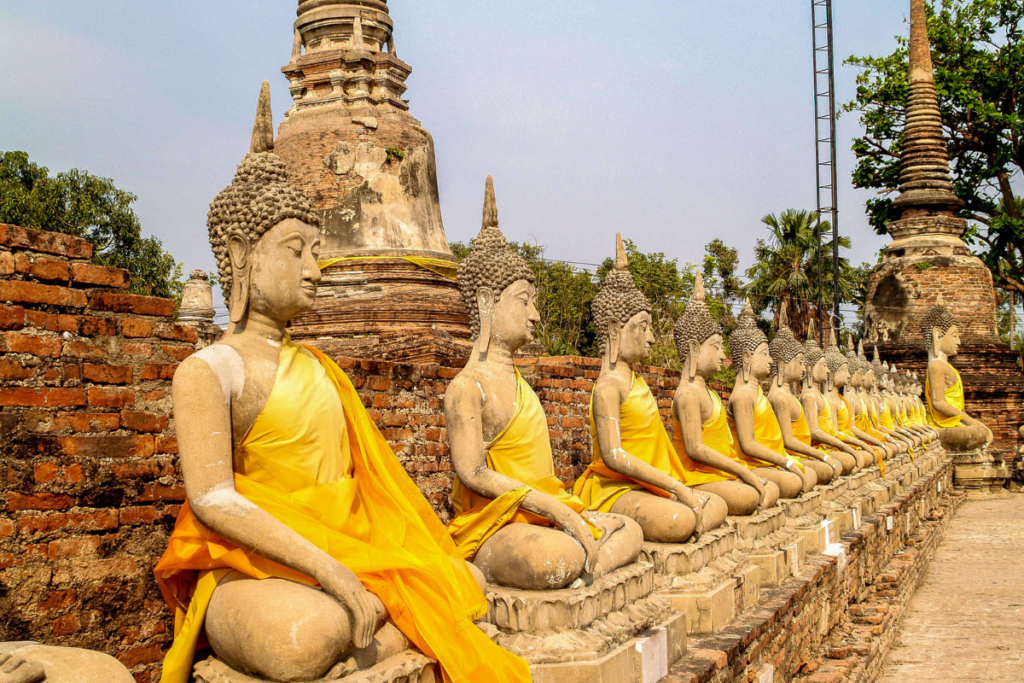
Ayutthaya, once a thriving port settlement, is now a UNESCO World Heritage Site and offers a glimpse into Thailand’s ancient capital. Visitors can explore the Ayutthaya Historical Park’s ruins, temples, and palaces. Highlights include the Temple of the Reclining Buddha, which houses a giant statue, and the ruins of over 400 temples and palaces.
Ayutthaya was the capital of the Kingdom of Siam from 1350 to 1767, and its grandeur can still be witnessed today in its impressive structures and artifacts. The city was known for its international connections and trade, attracting traders worldwide. However, in the 18th century, Ayutthaya was attacked by the Burmese and was eventually abandoned and left in ruins.
Today, visitors to Ayutthaya can immerse themselves in history as they explore the remnants of the once-glorious city. The Ayutthaya Historical Park is a vast area with ancient temples, towering pagodas, and ornate statues. The Temple of the Reclining Buddha, also known as Wat Lokayasutharam, is one of the most significant attractions. It houses a magnificent reclining Buddha image, measuring 42 meters long, covered in gold leaf, and surrounded by serene temple grounds.
The Ruins of Ayutthaya
- Wat Mahathat: One of Ayutthaya’s largest temples, known for the famous Buddha head entwined in tree roots.
- Wat Phra Si Sanphet: The former royal Palace, featuring three towering chedis.
- Wat Ratchaburana: Known for its impressive murals and underground crypt.
Temple of Ayutthaya
The Temple of Ayutthaya, also known as Wat Chaiwatthanaram, is another iconic site within the Ayutthaya Historical Park. This temple was built in 1630 and is renowned for its exquisite Khmer-style architecture and elaborate spires. Visitors can explore the ruins and admire the intricate stone carvings depicting scenes of Buddhist mythology.
A visit to Ayutthaya is a journey back in time, offering a fascinating glimpse into Thailand’s rich history and cultural heritage. Whether you are a history enthusiast, a photography lover, or simply curious about the ancient world, Ayutthaya’s historical sites will leave you in awe of their grandeur and significance.
📌The Grand Palace – Bangkok’s Iconic Landmark
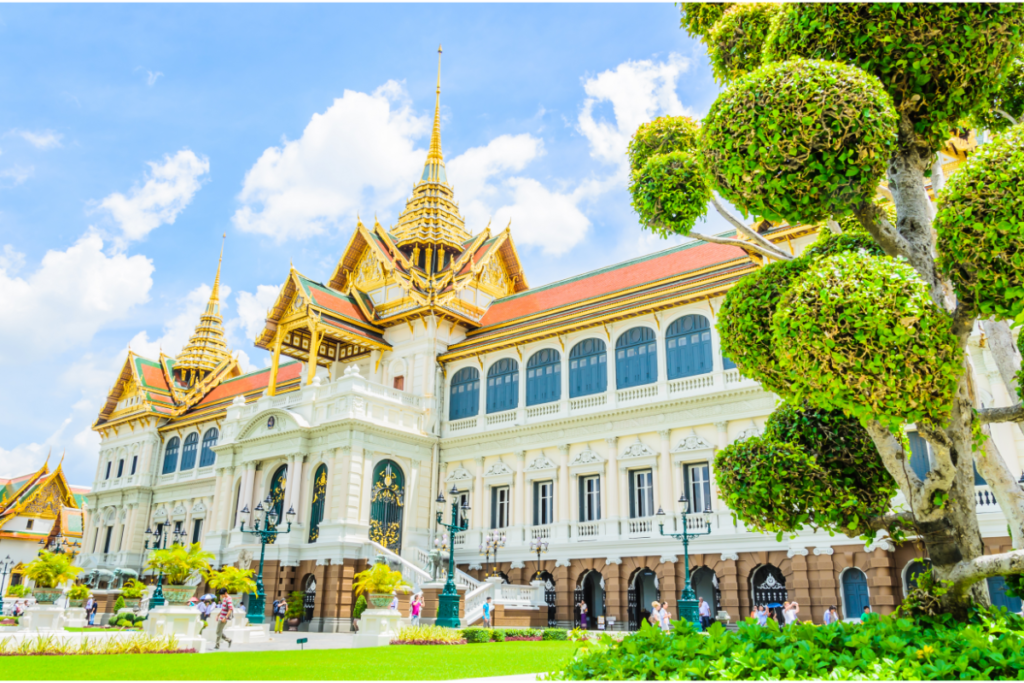
The Grand Palace in Bangkok is an iconic historical site that should not be missed during your visit to Thailand. This magnificent royal residence, built in the 18th century, showcases exquisite Thai-style architecture and offers a glimpse into the country’s rich history.
You will find many tourist attractions within the Grand Palace complex. From the intricate details of the government offices to the peaceful monasteries, each building within the Palace tells a story and is a testament to Thailand’s cultural heritage.
Government Offices
- The Grand Palace houses several intricately designed government offices that the Thai royal family once used. These buildings are adorned with ornate decorations, including colorful mosaics and delicate stucco designs, showcasing the craftsmanship of Thai artisans.
- One of the notable government offices is the Chakri Maha Prasat Throne Hall, which serves as a venue for important royal ceremonies and events. Its grandeur and architectural beauty are truly awe-inspiring.
Monasteries in the Grand Palace
- The Grand Palace is also home to several monasteries, including Wat Phra Kaew, which houses the famous Emerald Buddha, Thailand’s holiest and most revered statue of Buddha.
- Other monastic buildings within the Palace complex, such as the Phra Asada Maha Chedi and the Ubosot, display intricate carvings, gilded decorations, and beautiful murals depicting scenes from Buddhist mythology.
To fully immerse yourself in the history and significance of the Grand Palace, it is recommended to hire a guide who can provide detailed explanations and insights into this iconic landmark. With its grandeur and cultural significance, the Grand Palace is a must-visit destination in Bangkok, leaving you in awe of Thailand’s rich architectural and historical heritage.
📌Ancient Siam – A Living Museum
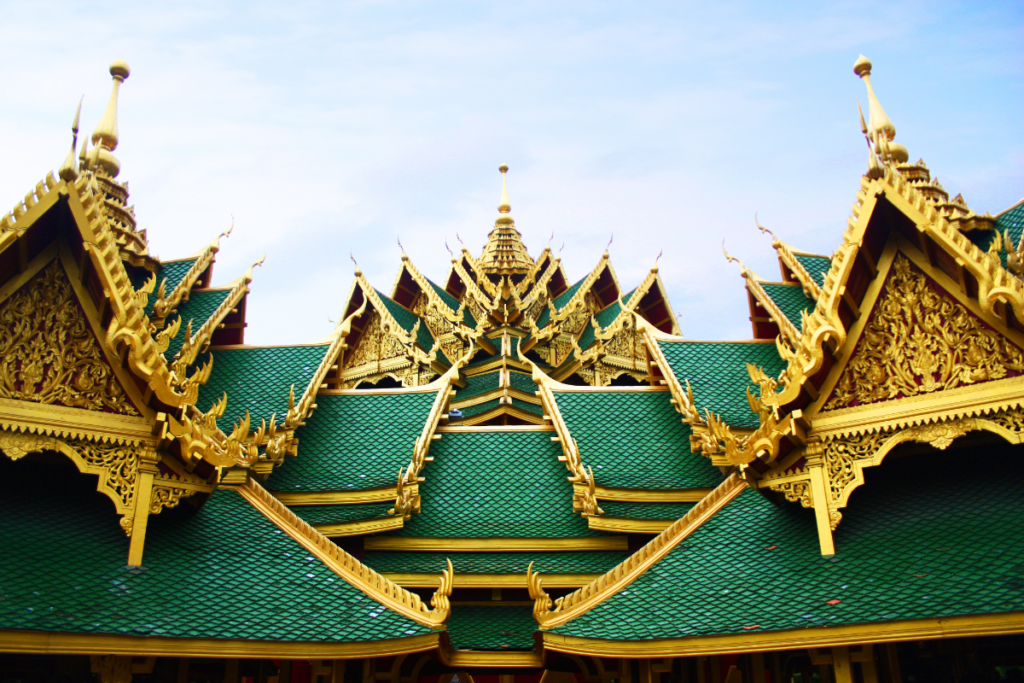
Ancient Siam offers a truly unique experience as an outdoor museum in Thailand. This expansive complex showcases miniature replicas of important historical sites nationwide. As you explore the grounds, you’ll see detailed recreations of landmarks such as the Tiger King’s Palace and the Ancient Theatrical Pavilion. While these artifacts may not be original, the attention to detail in the replicas is truly impressive.
Visiting Ancient Siam is like journeying through Thailand’s history in a single location. The outdoor museum provides a comprehensive overview of Thai heritage and culture. Each miniature replica is carefully crafted to capture the essence of the original site, allowing visitors to gain a deeper understanding of the country’s historical significance.
Discovering the Tiger King’s Palace and Ancient Theatrical Pavilion
Two notable highlights within Ancient Siam are the Tiger King’s Palace and the Ancient Theatrical Pavilion. The Tiger King’s Palace replica takes you back to the reign of King Rama V and offers a glimpse into the opulence and grandeur of the era. The Ancient Theatrical Pavilion showcases ancient Thailand’s vibrant performing arts scene, providing insight into traditional music, dance, and drama.
An Educational and Entertaining Experience
Whether you’re a history enthusiast, cultural explorer, or simply looking for an off-the-beaten-path attraction, Ancient Siam won’t disappoint. The outdoor museum seamlessly blends education and entertainment, making it an ideal destination for families, tourists, and locals. Exploring the miniature replicas and learning about Thailand’s rich history will leave you with a newfound appreciation for the country’s heritage.
📌Temple of the Reclining Buddha – A Sacred Shrine
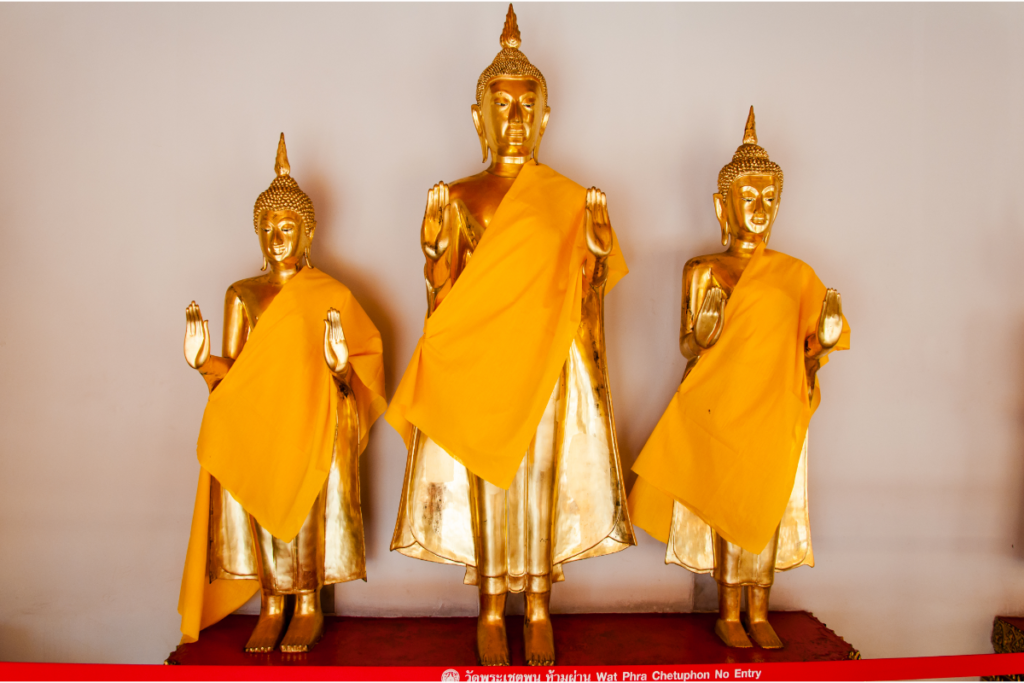
The Temple of the Reclining Buddha is one of Bangkok’s oldest and most sacred temples. Built-in 1788 by King Rama I, it holds great historical and religious significance. This majestic temple, also known as Wat Pho. It is a sight to behold as it houses over a thousand images of Buddha. Including the impressive Reclining Buddha, the largest portrayal of Buddha in Thailand.
The Oldest Sacred Temple in Bangkok
As the oldest temple in Bangkok, the Temple of the Reclining Buddha carries a rich heritage. It serves as a royal monastery of the first grade and holds the ashes of King Rama I. The temple complex features intricate architectural details, colorful murals, and golden decorations that reflect Thai culture and spirituality. Visitors can explore the beautiful temple grounds and admire the stunning gold-plated body of the Reclining Buddha. An astounding 15 meters tall and 43 meters long.
A Serene Royal Monastery
The Temple of the Reclining Buddha offers a serene and peaceful atmosphere for spiritual reflection. It is a place where locals and tourists alike come to pay their respects, offer prayers, and seek blessings. Inside the temple, you can witness the vibrant colors of the Buddha images. And the tranquil ambiance created by the soft lighting and fragrant incense. The temple complex also includes other structures and halls that house various Buddha statues. Making it an immersive experience for those interested in Buddhist art and history.
Visiting the Temple of the Reclining Buddha provides an opportunity to connect with the spiritual side of Thailand and appreciate the country’s cultural heritage. Whether you’re interested in religious sites or simply want to witness the grandeur of the Reclining Buddha. This sacred shrine is a must-visit during your time in Bangkok.
📌Kanchanaburi War Cemetery – A Tribute to Fallen Heroes

The Kanchanaburi War Cemetery, also known as the Don-Rak cemetery, is a solemn tribute to the prisoners of war (POWs). Who sacrificed their lives during the construction of the Death Railway. This historical site stands as a reminder of the hardships endured by Allied servicemen and Asian slave laborers during World War II.
Within the cemetery grounds, over 7,000 former POWs, mostly British, Australian, Dutch, and other Commonwealth servicemen, are laid to rest. The tranquil atmosphere invites visitors to reflect on the sacrifices and pay their respects to these fallen heroes.
Commemoration and Remembrance
- The Commonwealth War Graves Commission maintains the Kanchanaburi War Cemetery and serves as a place of commemoration and remembrance.
- Visitors can explore the well-kept grounds, marked by rows of white gravestones, and appreciate the peaceful surroundings.
- Each grave is meticulously cared for. Symbolizing the respect and honor bestowed upon those who lost their lives during the construction of the Death Railway.
The nearby Chungkai Cemetery is another important site that honors the memory of those who perished. It serves as a poignant reminder of the sacrifices made and the lasting impact of this dark historical period.
Visiting the Kanchanaburi War Cemetery is a powerful and emotionally moving experience. It allows you to pay your respects, gain a deeper understanding of the events that unfolded. And reflect on the significance of this chapter in Thailand’s history.
📌Kwai River Bridge – A Historic Landmark
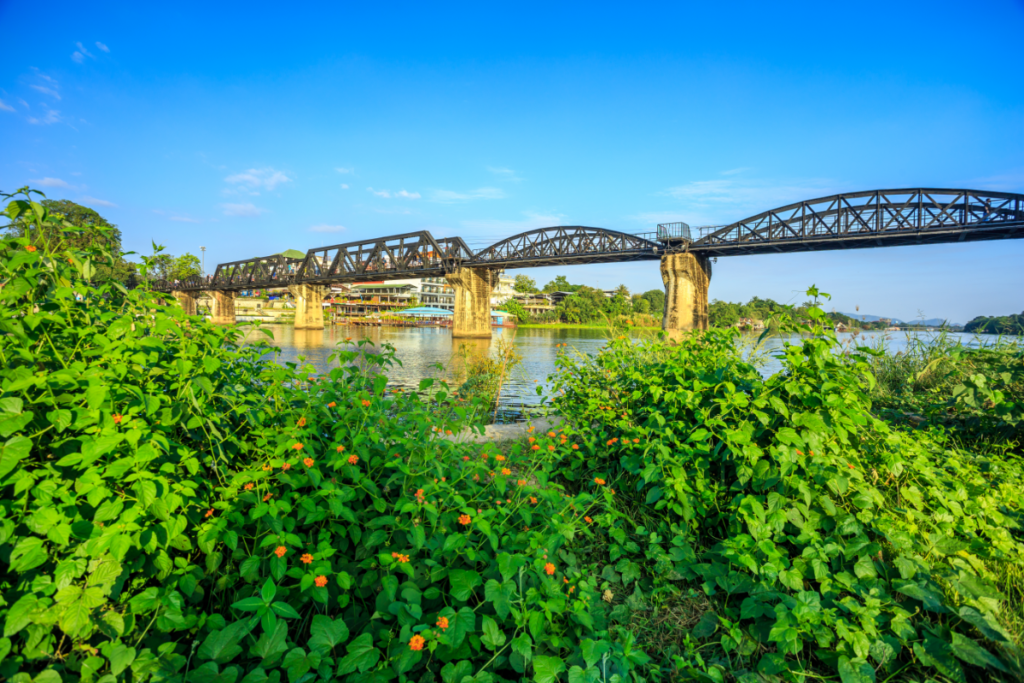
The Kwai River Bridge is a significant historical landmark that holds profound importance in Thailand’s history. Also known as the Death Railway Bridge, it was constructed during World War Two. Using the labor of prisoners of war (POWs) and Asian slave workers. This iconic bridge serves as a sad reminder of the hardships endured by those involved in its construction.
Visiting the Kwai River Bridge allows you to step back in time and reflect on the sacrifices made by the POWs and slave laborers. You can cross the bridge on foot, immersing yourself in its history and the picturesque landscape. Alternatively, you can take a tourist train that provides a unique perspective while offering informative commentary about the bridge’s harrowing past.
Each year, an annual light and sound show is held at the Kwai River Bridge to commemorate the bombing that took place during the war. This poignant event allows visitors to pay their respects to the fallen heroe. And gain a deeper understanding of the bridge’s historical significance.
Key Highlights of the Kwai River Bridge:
- Historic bridge built during World War Two
- Constructed using POWs and Asian slave laborers
- Opportunity to cross the bridge on foot or take a tourist train
- Annual light and sound show commemorating the bombing
📌Wat Pratat Doi Suthep – A Sacred Buddhist Temple

Wat Pratat Doi Suthep is a magnificent Buddhist temple and one of the most sacred sites in Thailand. Located near Chiang Mai, this ornate temple is renowned for its intricate religious carvings and stunning architecture. Legend has it that the temple was established in the 14th century by a white elephant carrying a relic of Buddha up the mountain. Thus marking the sacred origins of Wat Pratat Doi Suthep.
When visiting the temple, you can either climb the 309 steps. Which offers a picturesque and serene experience or take a tram for a more convenient journey. Once inside, you’ll be captivated by the beauty of the assembly hall, which houses a legendary 2-foot-tall statue of Buddha. The hall is adorned with golden decorations and intricate murals depicting the life of Buddha.
One of the most notable features of Wat Pratat Doi Suthep is the large white elephant statue, symbolizing the temple’s founding myth. This majestic statue serves as a reminder of the deep spiritual significance of the site. As you explore the temple grounds. You’ll also encounter other sacred structures, pagodas, and meditation areas that provide a tranquil atmosphere for contemplation and reflection.
📌Phra Pathom Chedi – Thailand’s Tallest Stupa
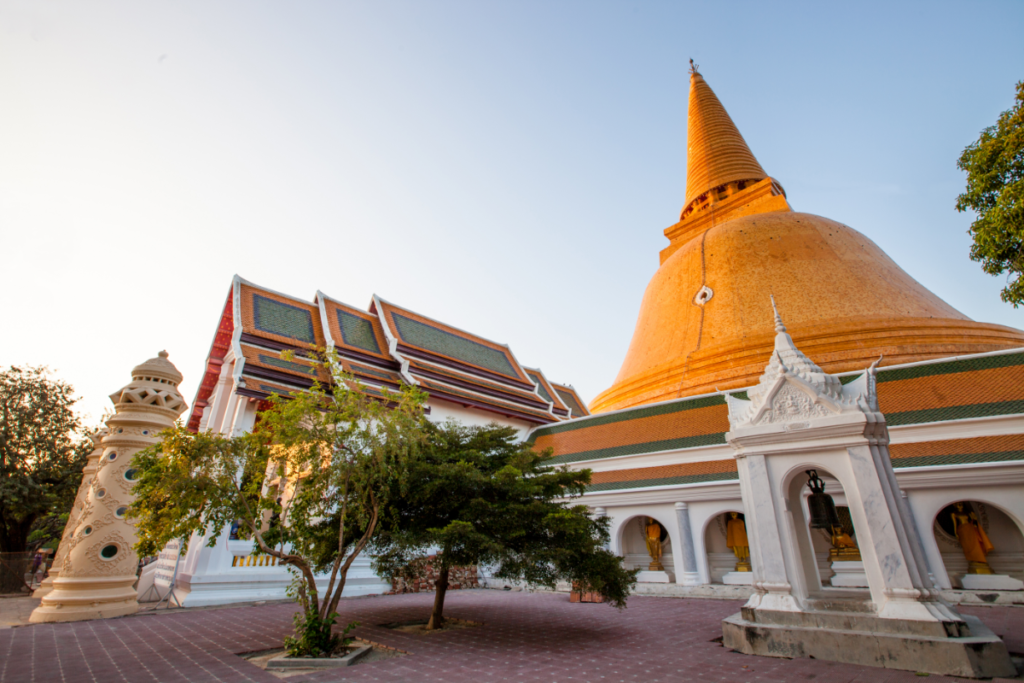
Phra Pathom Chedi is the tallest stupa in Thailand, reaching an impressive spire height of 124 meters. Although its exact historical origins remain unknown. This sacred site has been revered since Emperor Ashoka’s reign in the 3rd century BC. When viewed from above, the complex itself takes on the form of a giant Buddhist mandala. Symbolizing the harmonious union of all elements of the universe.
As you explore Phra Pathom Chedi, you will be captivated by the sheer magnitude of this architectural marvel. The stupa’s grandeur and intricate design reflect the rich cultural heritage of Thailand. Adorned with ornate carvings and sculptures, Phra Pathom Chedi is a testament to the country’s profound spiritual traditions.
Sacred Site and Archaeological Finds
Phra Pathom Chedi holds immense cultural and religious significance for Thai people, and it continues to be a place of pilgrimage for Buddhists from all over the world. Within the complex, you will discover a treasure trove of archaeological finds that offer insights into the region’s prehistoric past. From ancient relics to intricate artifacts, these discoveries provide a glimpse into the vibrant history of Thailand.
Immerse Yourself in the Giant Buddhist Mandala
Stepping foot into Phra Pathom Chedi is a truly awe-inspiring experience. The sprawling complex invites you to explore its tranquil grounds, delve into meditation and appreciate the beauty of the surrounding nature. As you wander the sacred site, you will feel a sense of tranquility and connection to the divine. The giant Buddhist mandala serves as a reminder of the interconnectedness of all beings and the boundless wisdom of the Buddha’s teachings.
📌Phanom Rung – Impressive Khmer Hindu Temple Complex
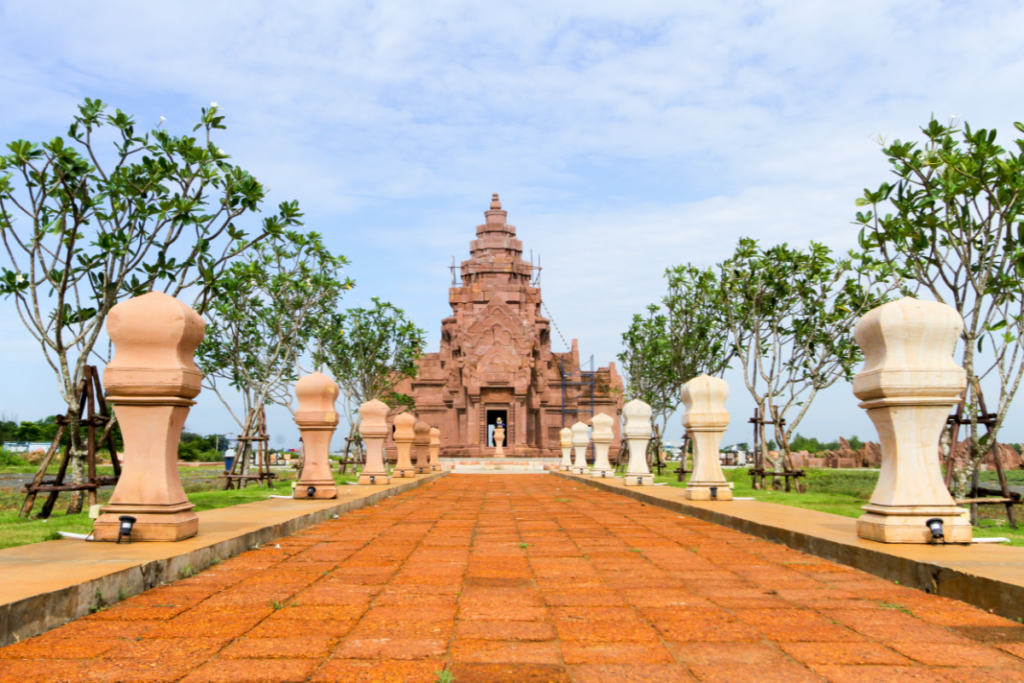
Phanom Rung is an extraordinary Khmer Hindu temple complex located on the edge of an extinct volcano. This ancient site, over 1,000 years old, is considered the best-preserved temple in Thailand. As you enter the complex through a magnificent processional walkway, you’ll be captivated by the grandeur and intricacy of the architecture, which showcases the mastery of ancient Khmer design.
The main tower of Phanom Rung is a sight to behold, offering breathtaking views of the surrounding landscape. The temple’s elevated position on the volcano adds to its mystical allure. As you explore the complex, you’ll also encounter the iconic Naga Bridge, a symbolic representation of the transition from the earthly world to the realm of the Gods.
Phanom Rung is a testament to the rich history and architectural prowess of the Khmer civilization. Its remarkable state of preservation allows visitors to truly immerse themselves in the ancient world. Whether you’re a history enthusiast or simply appreciate awe-inspiring structures, visiting Phanom Rung is an experience not to be missed.
Travel Tips When Visiting Historical Sites in Thailand
To make your adventure seamless and enriching, we’ve compiled essential travel tips for visiting historical sites in Thailand. From choosing the best times to understanding cultural etiquette, these insights will ensure your exploration is not just a visit but a cultural immersion.
1: Best Times to Visit
Timing is everything when it comes to exploring Thailand’s historical gems. The best times to visit these sites align with the country’s weather patterns. The cool, dry season from November to February is often considered ideal. During this time, the weather is more comfortable, allowing for pleasant exploration without the heat and humidity that characterize the rest of the year. However, remember that this is also the peak tourist season, so planning your visit during the shoulder seasons of late February to April or June to October may offer a more tranquil experience.
2: Cultural Etiquette
As you delve into the rich history of Thailand, respecting its cultural norms is key to a harmonious and meaningful experience. Remember to dress modestly when visiting temples and historical sites, covering your shoulders and knees. Remove your shoes before entering temple buildings as a sign of respect. While photography is generally allowed, exercise discretion, especially in sacred spaces. When interacting with locals, a simple way (a slight bow with pressed palms) is a courteous gesture. Additionally, refraining from public displays of affection and loud behavior is appreciated, maintaining the serene atmosphere of historical sites.
3: Local Currency and Entry Fees
Carry Thai Baht, the local currency, for smooth transactions at historical sites. While some sites may have entry fees, many offer discounted rates for foreigners. It’s advisable to check the official websites or inquire locally about entry fees and any special events or festivals that might impact your visit. Small denominations of currency can be helpful, especially when purchasing tickets or making small purchases at local stalls near historical sites.
4: Guided Tours and Information
Consider joining guided tours offered at historical sites. Local guides often provide valuable insights, historical anecdotes, and cultural context that enhance your understanding of the sites. English-speaking guides are commonly available, making the experience informative and engaging. Additionally, information boards and brochures are often provided at the entrances of historical sites, offering self-guided exploration options for those who prefer a more independent experience.
5: Responsible Tourism Practices
Embrace responsible tourism practices by respecting the natural and historical surroundings. Refrain from touching or climbing on ancient structures, which can contribute to deterioration. Dispose of litter in designated bins, and avoid disturbing local wildlife. By leaving only footprints and taking memories, you contribute to preserving Thailand’s historical sites for future generations.
So, tread lightly, immerse yourself in the history, and let the whispers of the past guide your footsteps through the remarkable historical tapestry of Thailand.
Frequently Asked Questions
Why should I visit historical sites in Thailand in my travel itinerary?
Exploring Thailand’s historical sites offers a captivating journey through the rich tapestry of its past. From ancient temples to royal palaces, these sites showcase the country’s cultural heritage, providing a deeper understanding of Thailand’s history and traditions. It’s like stepping back in time while enjoying the vibrant present.
What makes Thailand’s historical sites unique compared to other destinations?
Thailand’s historical sites stand out for their intricate architecture, ornate details, and spiritual significance. Each site tells a unique story, reflecting the country’s diverse influences and the resilience of its people. The blend of ancient charm and modern vibrancy makes Thailand’s historical sites a must-visit for a truly immersive experience.
Are historical sites only for history enthusiasts, or can anyone enjoy them?
Anyone can enjoy Thailand’s historical sites! Whether a history buff or just curious about different cultures, these sites offer a fascinating glimpse into the past. The stunning surroundings, cultural performances, and vibrant markets nearby ensure there’s something for everyone, making it a memorable experience for all visitors.
How can visiting historical sites contribute to a more meaningful travel experience?
Exploring historical sites in Thailand adds depth to your travel experience by connecting you with the country’s roots. It fosters a sense of appreciation for the local culture and traditions, creating a more meaningful and enriching journey. Plus, it’s an excellent way to interact with locals and learn firsthand about their heritage.
Are there any practical tips for making the most of a visit to historical sites in Thailand?
Wear comfortable clothing, stay hydrated, and consider hiring a local guide to get insider insights. Also, try to visit during off-peak hours for a more relaxed experience. Don’t forget your camera to capture the beauty, and be open to immersing yourself in the unique atmosphere of each historical site.
Can I visit historical sites with my family, or are they more suitable for solo travelers or couples?
Historical sites in Thailand are perfect for family visits! They offer a blend of educational and entertaining experiences suitable for all ages. Children can marvel at the architecture, enjoy cultural performances, and maybe even participate in interactive activities. It’s a wonderful way to create lasting memories for the whole family.
Final Words
So, it is clear why we should include a visit to historical sites in Thailand. The must-visit destinations in this country provide a unique opportunity to immerse yourself in the historical heritage of Thailand.
From the ancient city of Ayutthaya to the iconic Grand Palace in Bangkok, each historical site showcases impressive architecture, ruins, temples, and past stories. These sites are significant in terms of historical importance and reflect the cultural diversity and traditions that have shaped Thailand over the centuries.
Whether exploring the ancient ruins, paying homage to fallen heroes at war cemeteries, or marveling at the intricate Buddhist temples, each historical site is a testament to Thailand’s rich tapestry of history and culture. Including a visit to these historical sites in your travel plans will ensure an unforgettable experience and a deeper understanding of Thailand’s fascinating past.
So, if you’re planning a trip to Thailand, don’t miss the chance to explore these remarkable historical landmarks.
